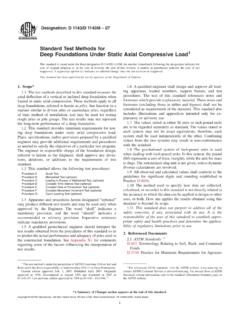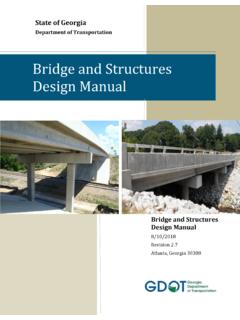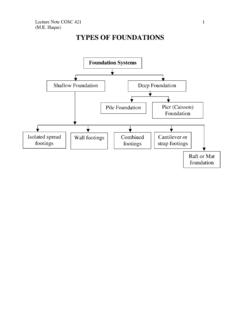Transcription of Standard Test Methods for Deep Foundations Under Static ...
1 Designation: D3689 07 Standard Test Methods forDeep Foundations Under Static axial Tensile Load1 This Standard is issued Under the fixed designation D3689; the number immediately following the designation indicates the year oforiginal adoption or, in the case of revision, the year of last revision. A number in parentheses indicates the year of last reapproval. Asuperscript epsilon ( ) indicates an editorial change since the last revision or Scope* The test Methods described in this Standard measure theaxial deflection of a vertical or inclined deep foundation whenloaded in Static axial tension. These Methods apply to all deepfoundations, referred to herein as piles, that function in amanner similar to driven piles or cast in place piles, regardlessof their method of installation, and may be used for testingsingle piles or pile groups.
2 The test results may not representthe long-term performance of a deep This Standard provides minimum requirements for test-ing deep Foundations Under Static axial tensile load. Plans,specifications, provisions, or any combination thereof preparedby a qualified engineer may provide additional requirementsand procedures as needed to satisfy the objectives of aparticular test program. The engineer in responsible charge ofthe foundation design, referred to herein as the engineer, shallapprove any deviations, deletions, or additions to the require-ments of this This Standard allows the following test procedures:ProcedureTestSectionAQuick Test (optional) in Excess of Maintained Test (optional) Time Interval Test (optional) Rate of Uplift Test (optional) Loading Test (optional) Apparatus and procedures herein designated optional may produce different test results and may be used only whenapproved by the engineer.
3 The word shall indicates amandatory provision, and the word should indicates arecommended or advisory provision. Imperative sentencesindicate mandatory A qualified geotechnical engineer should interpret thetest results obtained from the procedures of this Standard so asto predict the actual performance and adequacy of piles used inthe constructed foundation. SeeAppendix X1for commentsregarding some of the factors influencing the interpretation oftest A qualified engineer shall design and approve all load-ing apparatus, loaded members, support frames, and testprocedures. The text of this Standard references notes andfootnotes which provide explanatory material.
4 These notes andfootnotes (excluding those in tables and figures) shall not beconsidered requirements of the Standard . This Standard alsoincludes illustrations and appendices intended only for ex-planatory or advisory The values stated in either SI units or inch-pound unitsare to be regarded separately as Standard . The values stated ineach system may not be exact equivalents; therefore, eachsystem shall be used independently of the other. Combiningvalues from the two systems may result in non-conformancewith the The gravitational system of inch-pound units is usedwhen dealing with inch-pound units. In this system, the pound(lbf) represents a unit of force (weight), while the unit for massis slugs.
5 The rationalized slug unit is not given, unless dynamic(F=ma) calculations are All observed and calculated values shall conform to theguidelines for significant digits and rounding established The method used to specify how data are collected,calculated, or recorded in this Standard is not directly related tothe accuracy to which the data can be applied in design or otheruses, or both. How one applies the results obtained using thisstandard is beyond its ASTM International takes no position respecting thevalidity of any patent rights asserted in connection with anyitem mentioned in this Standard . Users of this Standard areexpressly advised that determination of the validity of any suchpatent rights, and the risk of infringement of such rights, areentirely their own test Methods are Under the jurisdiction of ASTM CommitteeD18on Soiland Rock and are the direct responsibility of edition approved Sept.
6 1, 2007. Published October 2007. Originallyapproved in 1978. Last previous edition approved in 1995 as D3689 90 (95) whichwas withdrawn December 2003 and reinstated in September 2007. DOI: *A Summary of Changes section appears at the end of this ASTM International, 100 Barr Harbor Drive, PO Box C700, West Conshohocken, PA 19428-2959, United States. Copyright by ASTM Int'l (all rights reserved); Mon Jul 5 12:16:21 EDT 2010 Downloaded/printed byAli Qzaz () pursuant to License Agreement. No further reproductions Standard does not purport to address all of thesafety concerns, if any, associated with its use. It is theresponsibility of the user of this Standard to establish appro-priate safety and health practices and determine the applica-bility of regulatory limitations prior to Referenced Standards.
7 2D653 Terminology Relating to Soil, Rock, and ContainedFluidsD3740 Practice for Minimum Requirements for AgenciesEngaged in Testing and/or Inspection of Soil and Rock asUsed in Engineering Design and ConstructionD5882 Test Method for Low Strain Impact Integrity Testingof Deep FoundationsD6026 Practice for Using Significant Digits in GeotechnicalDataD6760 Test Method for Integrity Testing of Concrete DeepFoundations by Ultrasonic Crosshole National Standards:ASME Gages and Gauge Attachments3 ASME Indicators (For Linear Measure-ments)33. For common definitions of terms used inthis Standard see of Terms Specific to This in-place pile ,n a deep foundation unit made ofcement grout or concrete and constructed in its final location, drilled shafts, bored piles, caissons, auger cast piles,pressure-injected footings, foundation,n a relatively slender structuralelement that transmits some or all of the load it supports to soilor rock well below the ground surface, such as a steel pipe pileor concrete drilled pile ,n a deep foundation unit made of pre-formed material with a predetermined shape and size andtypically installed by impact hammering, vibrating.
8 Or load,n for the purpose of terminating anaxial tensile load test, the test load at which continuing,progressive movement occurs, or at which the total axialmovement exceeds 15 % of the pile diameter or width, or asspecified by the rod,n an unstrained metal rod extendedthrough the test pile from a specific point to be used as areference from which to measure the change in the length ofthe loaded ,n a steel wire mounted with a constanttension force between two supports and used as a reference lineto read a scale indicating movement of the test Significance and Field tests provide the most reliable relationship be-tween the axial load applied to a deep foundation and theresulting axial movement.
9 Test results may also provideinformation used to assess the distribution of side shearresistance along the pile shaft and the long-term load-deflectionbehavior. A foundation designer may evaluate the test results todetermine if, after applying an appropriate factor of safety, thepile or pile group has an ultimate Static capacity and adeflection at service load satisfactory to support a specificfoundation. When performed as part of a multiple- pile testprogram, the designer may also use the results to assess theviability of different piling types and the variability of the If feasible, without exceeding the safe structural load onthe pile (s) or pile cap, the maximum load applied should reacha failure load from which the engineer may determine theultimate axial Static tensile load capacity of the pile (s).
10 Teststhat achieve a failure load may help the designer improve theefficiency of the foundation by reducing the piling length,quantity, or If deemed impractical to apply axial test loads to aninclined pile , the engineer may elect to use axial test resultsfrom a nearby vertical pile to evaluate the axial capacity of theinclined The quality of the result produced by these test Methods isdependent on the competence of the personnel performing it, and thesuitability of the equipment and facilities used. Agencies that meet thecriteria of PracticeD3740are generally considered capable of competentand objective testing/sampling/inspection/etc.






